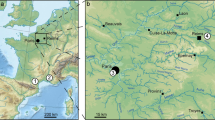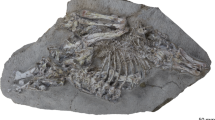Abstract
Alegeinosaurus aphthitos is a poorly known dissorophid from the early Permian Arroyo Formation of Texas that is represented by a partial articulated block of postcrania, including an articulated pectoral girdle, portions of the ribcage, and articulated vertebrae with osteoderms. It is one of several dissorophid taxa whose placement within the family is unquestioned, but whose anatomy and taxonomy are too poorly resolved to be relevant for current comparative and phylogenetic studies. A redescription of the holotype is presented here to provide a more thorough characterization of its morphology and to address its taxonomic standing. Various aspects of the postcrania conform to those previously reported from the basal dissorophid Aspidosaurus, in particular the unique nature of a single series of keeled osteoderms fused to transversely expanded dorsal tips of the spines. Alegeinosaurus is herein designated as a junior synonym of Aspidosaurus, thereby resolving the relationships of a poorly known taxon and expanding the characterized postcranial regions of Aspidosaurus for future comparative work on dissorophid postcrania.




Similar content being viewed by others
References
Anderson, J.S., A.C. Henrici, S.S. Sumida, T. Martens, and D.S. Berman. 2008. Georgenthalia clavinasica, a new genus and species of dissorophoid temnospondyl from the Early Permian of Germany, and the relationships of the Family Amphibamidae. Journal of Vertebrate Paleontology 28: 61–75.
Berman, D.S., and S.G. Lucas. 2003. Aspidosaurus binasser (Amphibia, Temnospondyli), a new species of Dissorophidae from the Lower Permian of Texas. Annals of Carnegie Museum 72: 241–262.
Bolt, J.R. 1969. Lissamphibian origins: possible protolissamphibian from the Lower Permian of Oklahoma. Science 166 (3907): 888–891.
Boulenger, G.A. 1902. Amphibia, In Vol. 1, Encyclopaedia Britannica, 10th ed., 381–384. London: Adam and Charles Black.
Broili, F. 1904. Permische Stegocephalen und Reptilien aus Texas. Palaeontographica 51: 1–120.
Carroll, R.L. 1964. Early evolution of the dissorophid amphibians. Bulletin of the Museum of Comparative Zoology 131: 161–250.
Case, E.C. 1907. Additional description of the genus Zatrachys Cope. Bulletin of the American Museum of Natural History 23: 665–668.
Case, E.C. 1911. Revision of the Amphibia and Pisces of the Permian of North America. Publications of the Carnegie Institution of Washington 146: 1–179.
Cope, E.D. 1881. On some new Batrachia and Reptilia from the Permian Beds of Texas. Bulletin of the United States Geological and Geographical Survey of the Territories 6: 79–82.
Cummins, W.F. 1908. The localities and horizons of Permian vertebrate fossils in Texas. The Journal of Geology 16: 737–745.
DeMar, R.E. 1966. The functional and phylogenetic significance of the armor of dissorophid amphibians. Fieldiana Geology 16: 55–88.
DeMar, R. 1968. The Permian labyrinthodont amphibian Dissorophus multicinctus, and adaptations and phylogeny of the family Dissorophidae. Journal of Paleontology 42: 1210–1242.
Dilkes, D., and L.E. Brown. 2007. Biomechanics of the vertebrae and associated osteoderms of the Early Permian amphibian Cacops aspidephorus. Journal of Zoology 271: 396–407.
Eichwald, E. von. 1848. Über die Saurier des kupferführenden Zechsteins Russlands. Bulletin de la Société National Moscou 21: 136–204.
Fröbisch, N.B., and R.R. Reisz. 2012. A new species of dissorophid (Cacops woehri) from the Lower Permian Dolese quarry, near Richards Spur, Oklahoma. Journal of Vertebrate Paleontology 32: 35–44.
Gee, B.M., and R.R. Reisz. 2018a. Cranial and postcranial anatomy of Cacops morrisi, a eucacopine dissorophid from the early Permian of Oklahoma. Journal of Vertebrate Paleontology 38 (2): e1433186.
Gee, B.M., and R.R. Reisz. 2018b. Postcrania of large dissorophids from Richards Spur. Oklahoma. Fossil Record 21 (1): 79–91.
Gordon, C.H., G.H. Girty, and D. White. 1911. The Wichita Formation of northern Texas. The Journal of Geology 19: 110–134.
Gubin, Y.M. 1980. New Permian dissorophids of the Ural forelands. Paleontologiceskij Zhurnal 1980 (3): 82–90.
Gubin, Y.M. 1993. New data on lower tetrapods from the Upper Permian of the Northern Urals and Obshchiy Syrt regions. Paleontologiceskij Zhurnal 1993 (4): 97–105. (in Russian).
Holmes, R., D.S. Berman, and J.S. Anderson. 2013. A new dissorophid (Temnospondyli, Dissorophoidea) from the Early Permian of New Mexico (United States). Comptes Rendus Palevol 12: 419–435.
Li, J.-L., and Z.-W. Cheng. 1999. New anthracosaur and temnospondyl amphibians from Gansu, China—the fifth report on late Permian Dashankou lower tetrapod fauna. Vertebrata PalAsiatica 37: 242–247.
Maddin, H.C., N.B. Fröbisch, D.C. Evans, and A.R. Milner. 2013. Reappraisal of the Early Permian amphibamid Tersomius texensis and some referred material. Comptes Rendus Palevol 12: 447–461.
May, W., A.K. Huttenlocker, J.D. Pardo, J. Benca, and B.J. Small. 2011. New Upper Pennsylvanian armored dissorophid records (Temnospondyli, Dissorophoidea) from the US midcontinent and the stratigraphic distributions of dissorophids. Journal of Vertebrate Paleontology 31: 907–912.
Milner, A.R. 2003. Longiscitula houghae DeMar 1966 (Amphibia: Temnospondyli), a junior synonym of Dissorophus multicinctus Cope, 1895. Journal of Vertebrate Paleontology 23: 941–944.
Olson, E.C. 1965. New Permian vertebrates from the Chickasha Formation in Oklahoma. Circular of the Oklahoma Geological Survey 1965: 1–70.
Reisz, R.R., R.R. Schoch, and J.S. Anderson. 2009. The armoured dissorophid Cacops from the Early Permian of Oklahoma and the exploitation of the terrestrial realm by amphibians. Naturwissenschaften 96: 789–796.
Romer, A.S. 1928. Vertebrate faunal horizons in the Texas Permo-Carboniferous red beds. University of Texas Bulletin 2801: 67–108.
Romer, A.S. 1947. Review of the Labyrinthodontia. Bulletin of the Museum of Comparative Zoology 99: 1–368.
Romer, A.S., and L.I. Price. 1940. Review of the Pelycosauria. Geological Society of America, Special Papers 28: 1–528.
Schoch, R.R., and H.-D. Sues. 2013. A new dissorophid temnospondyl from the Lower Permian of north-central Texas. Comptes Rendus Palevol 12: 437–445.
Schoch, R.R. 2012. Character distribution and phylogeny of the dissorophid temnospondyls. Fossil Record 15: 121–137.
Schoch, R.R. 2013. The evolution of major temnospondyl clades: an inclusive phylogenetic analysis. Journal of Systematic Palaeontology 11 (6): 673–705.
Schoch, R.R., and A.R. Milner. 2014. Handbook of Paleoherpetology—Temnospondyli I. München: F. Pfeil.
Vaughn, P.P. 1971. A Platyhystrix-like amphibian with fused vertebrae, from the Upper Pennsylvanian of Ohio. Journal of Paleontology 45 (3): 464–469.
White, C.A. 1889. On the Permian formation of Texas. The American Naturalist 23: 109–128.
White, C.A. 1891. The Texan Permian and its Mesozoic types of fossils. U.S. Geological Survey Bulletin 77: 1–51.
Williston, S.W. 1910. Cacops, Desmospondylus; new genera of Permian vertebrates. Geological Society of America, Bulletin 21: 249–284.
Williston, S.W. 1911. American Permian vertebrates, 1–145. Chicago: University of Chicago Press.
Williston, S.W. 1914. Broiliellus, a new genus of amphibians from the Permian of Texas. The Journal of Geology 22: 49–56.
Witzmann, F., and R. Soler-Gijón. 2010. The bone histology of osteoderms in temnospondyl amphibians and in the chroniosuchian Bystrowiella. Acta Zoologica 91: 96–114.
Zittel, K. von. 1888. Handbuch der Paläontologie Abteilung 1. Paläozoologie Band III. Vertebrata (Pisces, Amphibia, Reptilia, Aves), 1–900. Munich, Leipzig: Oldenbourg.
Acknowledgements
I thank C. Mehling and M. Norell for facilitating a collection visit to the American Museum of Natural History (AMNH). Thanks to the reviewers, F. Witzmann and P. Skutschas, and to the Associate Editor, N. Fröbisch, for insightful comments that improved this manuscript.
Author information
Authors and Affiliations
Corresponding author
Additional information
Handling Editor: Nadia Fröbisch.
Rights and permissions
About this article
Cite this article
Gee, B.M. Reappraisal of the early Permian dissorophid Alegeinosaurus from Texas, USA. PalZ 92, 661–669 (2018). https://doi.org/10.1007/s12542-018-0421-9
Received:
Accepted:
Published:
Issue Date:
DOI: https://doi.org/10.1007/s12542-018-0421-9




